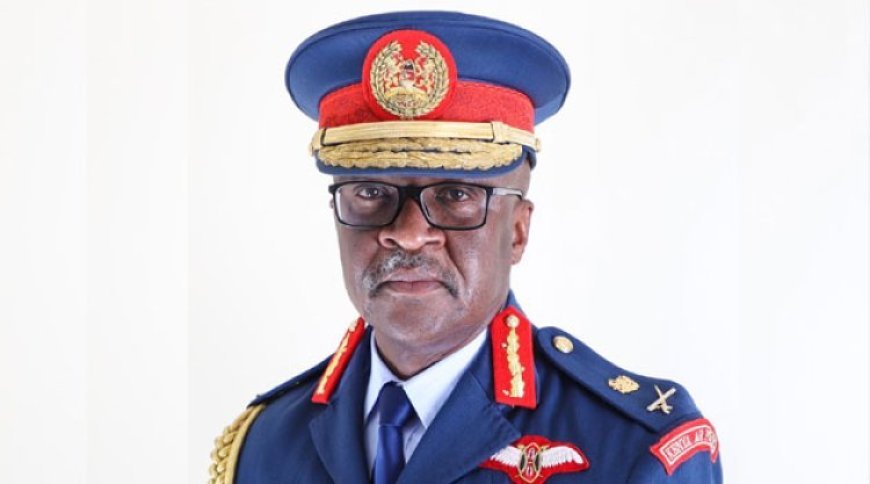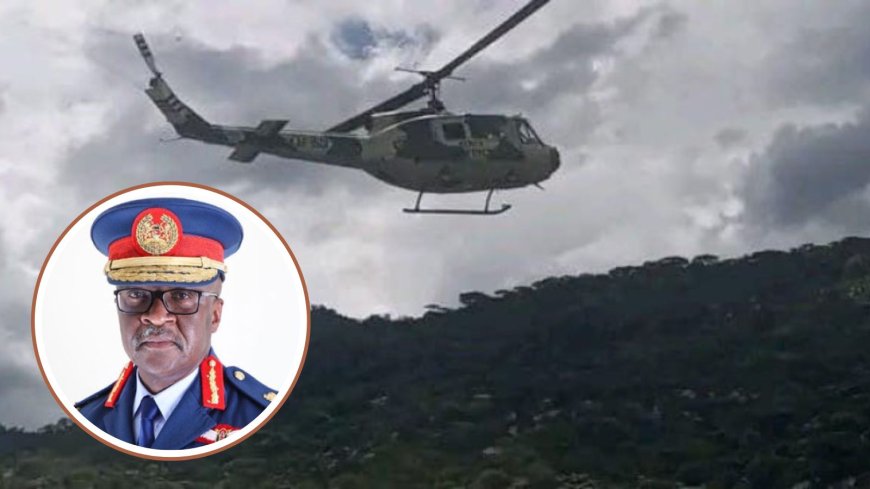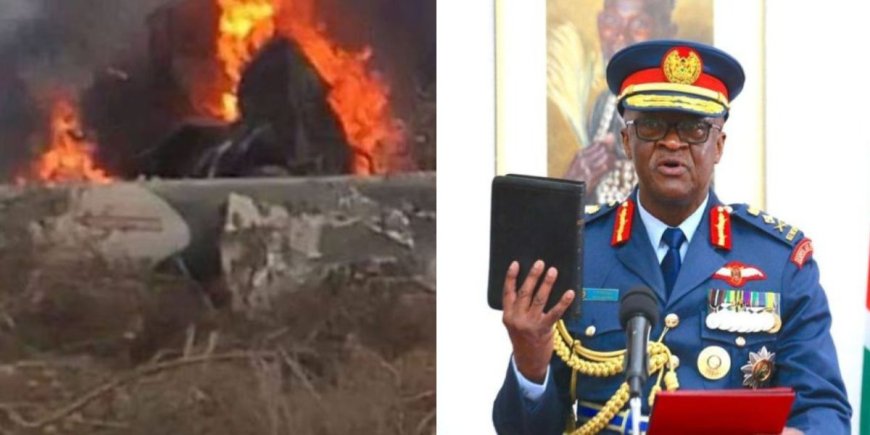A probe into the helicopter crash that claimed the life of former Chief of Defence Forces (CDF) General Francis Ogolla confirmed on Friday, April 11, that the incident was caused by an engine malfunction.
The Ministry of Defence released a report close to a year after the crash happened in Elgeyo Marakwet County, outlining a comprehensive analysis of all elements surrounding the crash to pinpoint its exact cause.
Findings revealed that technical experts from the Ministry of Defence, along with aviation investigators, determined that the Kenya Air Force helicopter experienced a major engine failure shortly after taking off from West Pokot—ultimately causing the deadly crash.
The report evaluated several factors, including the aircrew and technical components, mission planning and execution, weather conditions, individual character traits, crew coordination and cooperation. Communication systems and the engine were also reviewed. All were ruled out as likely causes of the crash, except for the engine, which stood out as the primary concern.

File image of the late former Chief of Defence Forces Lt Gen Francis Omondi Ogolla. /KDF
"The Helicopter suffered Engine Compressor Stall (Surge), which is consistent with the witness report of a loud bang at the Engine compartment and the Measured Gas Temperature (MGT) gauge, which, when powered, displayed an Over-Exceedance of 914 °C. The Helicopter then experienced a Complete Power Loss, which was followed by 5 a left yaw, drop in Engine RPM, low RPM audio alarm and change in engine noise, as narrated by witnesses on the ground and accident scene reconstruction," the report earlier obtained by Viral Tea disclosed.
What Is a Compressor Stall (Surge)?
A compressor stall happens in the gas turbine engine — the heart of most helicopters. In simple terms, it is when the airflow through the compressor becomes unstable.
Normally, air flows smoothly from the intake, through the spinning compressor blades, and gets squeezed (compressed) before being ignited in the combustion chamber. This process is what gives helicopters that consistent engine power.
However, during a stall, that airflow gets disrupted. Instead of moving forward through the compressor, some or all of the air might reverse direction or start swirling chaotically inside the engine.
This sudden breakdown in airflow causes a loss of compression pressure, which then leads to a sharp drop in engine power. In extreme cases, it sounds like a loud bang, almost like a backfire, and can shoot flames out of the intake or exhaust, not a good sight.
Why Does This Happen?
Compressor stalls can be triggered by a few different things:
- Abrupt throttle changes, like when the pilot aggressively pulls power.
- Disturbed or turbulent air intake, especially when flying at odd angles, near mountains, or in a hover in strong winds.
- Mechanical issues, like damaged or dirty compressor blades.
- Hot and high conditions, that is, thin air at high altitudes or hot temperatures that can mess with air pressure balance.
In fixed-wing jets, this is bad but often survivable. In helicopters? It can be fatal, and in this case, it was fatal.
How It Can Crash a Helicopter
Unlike airplanes, helicopters rely on rotor power every second just to stay in the air. There is no "gliding" to safety — if engine power decreases or shuts down unexpectedly, the aircraft can drop like a rock unless the pilot reacts instantly with autorotation maneuvers (which are hard to pull off, especially at low altitudes).
Here’s how a compressor stall can lead to a crash:
-
Loss of power = loss of rotor rotations per minute (RPM). That’s critical. The rotors need to spin fast to keep the helicopter airborne and controllable.
-
Rapid rotor RPM decay means the pilot might not even have time to enter autorotation. If the engine switches off during a hover or low-altitude maneuver, you’re out of options.
-
If it's a twin-engine helicopter, and one engine surges or stalls, it might put uneven torque on the system, potentially leading to control issues or overloading the remaining engine, which could then fail too.
In military or rescue missions, where helicopters fly in difficult conditions (tight spaces, bad weather, heavy loads), compressor stalls are particularly dangerous. One stall at the wrong time — like during a landing on a mountain ledge or hovering near obstacles — and it’s game over.
Bottom Line
Compressor stalls are no joke, especially for helicopters. They’re the kind of failure that can come suddenly, leave zero margin for error, and result in total engine loss.
That’s why pilots train for it, and engines are designed with systems to minimize the risk — but it still happens, and when it does, it’s one of those critical, high-stakes moments that separates life from death.
How The KDF Chopper Crash Occurred
The report revealed that the fatal crash occurred just two minutes after take-off, following multiple stopovers in the North Rift region.
The Bell UH-1H-II (Huey) helicopter, registration KAF 1501, departed from Nairobi’s Wilson Airport on April 18, 2024, for an inspection tour of military operations across Baringo, Elgeyo Marakwet, and West Pokot counties. The mission included a series of refuelling stops, first in Chesit and then again in Kainuk.
According to the report, “They then briefed for the next flight to Kainuk and Chesogon.” After the briefing, the team flew to Cheptulel Boys High School in Chesogon, landing at 1:36 pm to visit troops stationed there.
At approximately 2:00 pm, the helicopter took off for Eldoret, where they were scheduled to arrive at the Defence Forces Recruits Training School. Tragically, the aircraft crashed just 1.3 nautical miles from the school, in an area known as Shamba la Amani.

A KDF Chopper before crashing on Thursday, April 18, 2024 and the late CDF Francis Ogolla (inset). /VIRAL TEA KE ARCHIVES
The chopper ignited on impact, erupting into flames. Nearby military personnel from Samu Forward Operating Base, along with residents, responded quickly, managing to rescue several passengers and contain the fire.
Four survivors were airlifted to Endo Health Centre using Hughes MD 500 helicopters, but two later succumbed to their injuries. The remaining two were transferred to Eldoret Regional Hospital for further treatment. 10 bodies were subsequently transported to Nairobi.
"The Helicopter suffered Category Five (Cat 5) Damage (Beyond Economic Repair)," the report read in part.









